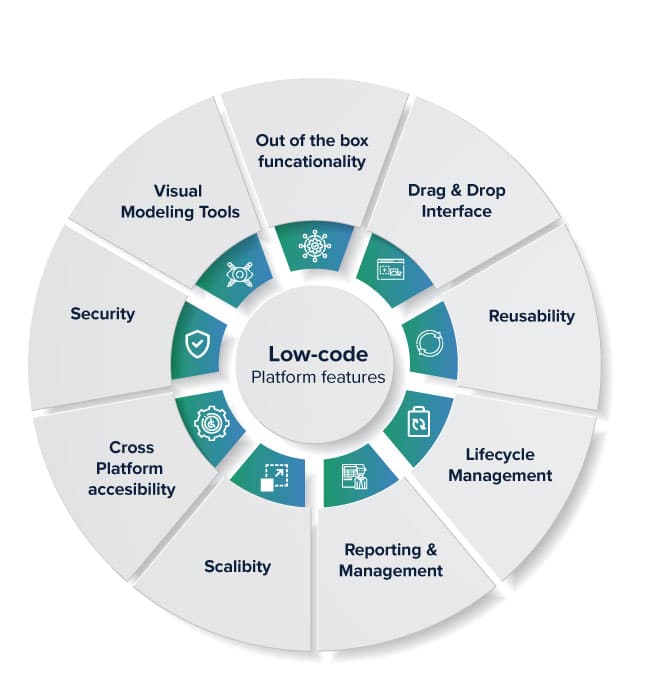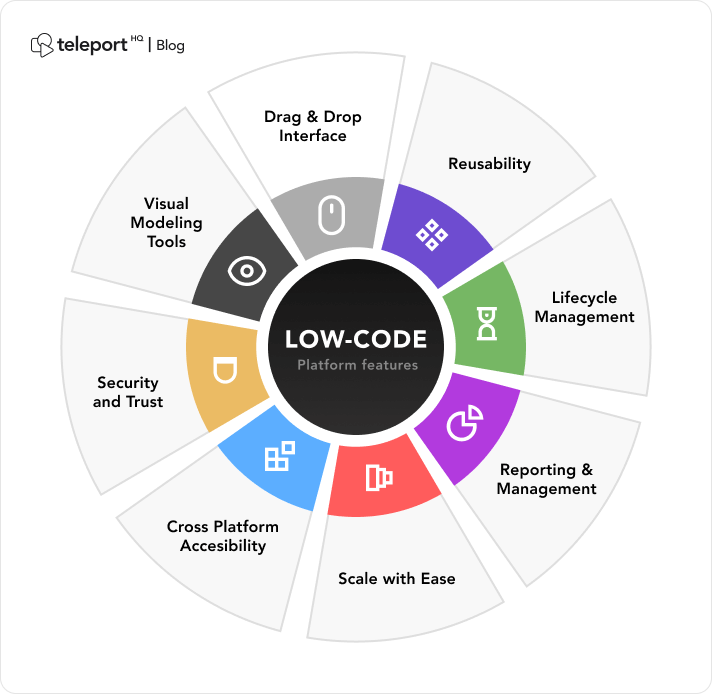New Suggestions For Selecting Low-Code Platform Info
New Suggestions For Selecting Low-Code Platform Info
Blog Article
Benefits Of Low-Code Application Development In Terms Of Integration Capabilities
Low-code development of apps has numerous benefits, especially in terms integration. This is important in creating apps that effortlessly connect to systems and other services. Here are a few of the main advantages: Prebuilt Connectors and APIs
A wide range of connectors available Low-code platforms have a vast collection of pre-built connectors to popular enterprise system (e.g. CRM, ERP databases cloud services, etc.). The integration process is simplified.
API Integration - A lot of low-code platforms include API integration, allowing developers to easily access other data sources or external services.
User-Friendliness
Drag-and-Drop Integration integration tasks can usually be done using drag-and drop interfaces, making it possible for both developers and non-developers to create complex integrations, without writing lots of code.
Visual Workflow builders Visual Workflow Builders utilized to design workflows, data flow, and integrations. They aid in understanding and setting up workflows more efficiently.
Standardized Integration Methods:
SOAP and Restful Service: Using standard web service protocols like SOAP and REST allows you to integrate with other systems and applications.
OData Standards and other Standards Support for standards, such as OData provides easy access to data as well as its manipulation across various platforms and apps.
Real-Time Data Synchronization:
Real-Time Integrations: Low-code platforms can handle the real-time synchronization of data between systems, applications as well as databases. This will ensure that data is up-to-date and consistent throughout an organization.
Event-Driven Architecture: Certain platforms come with event-driven architectural designs which allow applications to react in real-time to events, essential for interactive, dynamic applications.
Legacy System Integration:
Low-code platforms offer a variety of tools to connect with existing systems. They allow organizations to modernize IT without having to overhaul their existing systems.
Data Migration: Built-in tools allow you to transfer data from old applications to new ones built on platforms that use low-code.
Integration of Third-Party Services:
Cloud Services Integration: Easy scaling and deployment of apps is possible with seamless integration with cloud services like AWS, Azure and Google Cloud.
Business Applications Integration Lowcode platforms can be utilized to connect various business applications, such as Salesforce, SAP, Microsoft Dynamics etc. to create a seamless workflow that spans different functions of business.
Simplified Data Processing
Unified data models: Certain platforms offer low-code support for unified models of data to facilitate data management across systems.
Data connectors: Data connectors that are preconfigured to give easy access and control to data from a variety of sources.
Security and Compliance
Secure Integrations - Low-code platforms have been designed to make sure that integrations adhere to security protocols and standards. This protects data both in transit and when it is stored.
These platforms are often packed with features to in ensuring conformity (e.g. HIPAA, GDPR) and provide assurance to companies dealing with sensitive data.
Extensibility:
Custom Codes and scripts. For more complex needs in integration, low-code platform usually allows the use of custom code and scripts. This allows flexibility without compromising user ease.
Plug-in Ecosystem: An ecosystem of plugins and extensions can enhance the integration capabilities, allowing users to add new functionalities as needed.
Overall, integration capabilities within low-code application development platforms permit them to be a powerful platform for creating integrated, efficient, scalable, and interconnected applications. They simplify the process of connecting disparate systems, enhance data flow and allow businesses to adopt new technologies while leveraging existing ones. Take a look at the top rated continue reading for Low-code Platform for application development for blog advice including cross platform app development, rapid app development, application modernization software, ms azure sql, app modernization, stored sql procedures, cross platform app development, cross platform app dev, build a docker container, cross platform app development and more.
Advantages Of Low-Code Application Development In Terms Of Flexibility And Scalability
Low-code application development has many advantages in terms of scalability and flexibility, which are vital to build applications that can expand with the needs of businesses and change with the demands of business. Here are a few main benefits Rapid scaling:
Cloud-based deployment: A lot of lowcode platforms are based on the cloud, allowing applications to scale with the infrastructure. This lets businesses handle the increased workload without worrying about the management of servers.
Auto-Scaling Feature: Built-in features that automatically scale resources in order to satisfy demand, ensuring consistent performance without manual input in peak hours.
Flexible Architecture:
Modular design Low-code platforms are fantastic way to encourage modular applications. This allows components to be designed and developed on their own and tested, scaled and so on. This is a fantastic way to increase flexibility. It also makes it easy to update and expand parts of a system without having the whole application affected.
Microservices Integration Microservices Architecture support lets applications to be developed as a set of loosely coupled services, which improves both scalability and flexibility.
Customizable Solutions:
Extensibility Low-code systems typically allow for custom-written code and scripting. Developers can enhance the capabilities of their applications beyond what is available out of the box. This ensures that unique business needs can be fulfilled without constraints.
Third-Party Integrations: The incorporation of third-party services, APIs or other types of services permits companies to expand the functionality of their application by incorporating additional functions.
Agile Development Deployment, Agile Development Agile Development:
Continuous delivery and deployment Low-code platforms can be used with agile methodologies and facilitate continuous integration and delivery (CI/CD). This allows rapid deployment of updates and the introduction of new features, which allows applications to develop rapidly in response to the feedback of users and changes in the market.
Iterative Development: The nature of development using low-code ensures that applications can be incrementally improved and scaled, reducing the risk associated with large-scale changes and allows for greater control over growth.
Resource Optimization
Efficiency in Resource Management: Low-code systems assist optimize the usage of resources through providing tools to monitor and manage application performance. This lets resources be utilized efficiently and they can also be sized up or down according to the need.
Load Balancing : The integrated load balancing feature divides the workload equally across servers. This improves the system's ability to handle large volumes of traffic and also ensures consistent performance.
Global Reach
Multi-Region: Low-code platform deployments are typically supported across multiple geographies which allows businesses to offer low latency access to all users. This is particularly important for apps that have a global user base.
Localization Support : Built-in language support enables applications to be modified to accommodate different local languages and requirements. This allows them to be more flexible on diverse markets.
Maintenance and Updates
Simple Maintenance : Low-code applications are modular and visual. This simplifies maintenance tasks. This lets bugs and updates to be made quickly, with no long periods of downtime.
Version Control Systems that integrate versions control can help you manage updates, rollbacks and changes. They will make sure that they are released in a safe manner and that previous versions can be restored if necessary.
Cost Efficiency:
Lower Development Costs: By cutting down on the need for a lot of programming, low-code platforms reduce development costs and make it feasible to scale applications without significant increase in development cost and effort.
Pay-As-You Go Models - Many low-code applications have flexible pricing models such as pay-as-you-go, which aligns costs with actual usage, growth and financial flexibility.
Overall, low-code app development offers businesses the flexibility and capacity they require to develop robust and flexible applications. These platforms can quickly adjust to changing demands and efficiently use resources, and continually improve, allowing apps and companies alike to grow and expand. See the top rated home page about Enterprise application development with Low-code Platform for more recommendations including mobile development platforms, app modernisation, push notifications, azure sql, push alerts, develop cross platform mobile app, mobile development platforms, cross platform mobile dev, app platforms, multiplatform mobile app development and more.
Community And Support From The Vendor Are Two Advantages Of Low Code Application Development.
Low-code platforms have significant advantages both in terms of community involvement and vendor support Both of which are essential for success in the implementation, maintenance and improvement of software. Here are some of the main advantages.
Comprehensive Technical Support:
Dedicated Support Teams: Many low-code platforms have access to dedicated support teams who can help in technical problems, troubleshooting and provide guidance to ensure that any problems are resolved quickly.
Help is accessible 24/7: Numerous vendors offer round-the-clock support which is particularly beneficial for companies that operate in multiple time zones.
Training and Onboarding
Vendors provide structured training programs such as webinars, tutorials and certifications to assist users in becoming familiar with the platform.
Personalized Onboarding Many vendors provide customized services that help new clients implement the platform successfully and tailor it specifically to their needs.
Regular updates and enhancements
Continuous Improvement: Low code platform providers regularly release updates that include updates to security patches, features and improvements to performance. This helps ensure that the platform is always current and safe.
Feedback integration: Vendors will frequently incorporate feedback from users during their process of development to ensure that their platform is able to meet the changing demands of their users.
Comprehensive Documentation:
Documentation is detailed users are able to access a wealth of well-organized documents, which range in complexity from simple modification to advanced.
API References API documentation can aid developers build and integrate apps using the Low-Code platform.
Professional Consulting Services
Expert Consulting : Vendors offer consultancy services, including the design of architectures and complicated implementations. They provide this service in order to make sure that their users are able take full advantage of the platform.
Custom Development Services Certain companies offer customized development services to build specific functions and integrations that are not available as standard.
Community Support for the Community
Active User Groups:
Forums and discussion boards Discussion boards and forums: Many low-code platforms have active online communities where users can ask questions, exchange solutions and work together on best practices.
User Groups and Meetups Local and virtual user groups and meetups provide opportunities to meet, network and sharing experiences with other users.
Knowledge Sharing and Collaboration:
Community-Contributed Resources: Users often share templates, modules, and extensions that they have developed, which can be reused or adapted by others, accelerating development and innovation.
Crowdsourced Solutions: The collective knowledge the experience, expertise and experiences of a community can prove to be a useful tool in problem-solving and finding innovative solutions.
Learning and Development
Community-led Training: A lot of groups host workshops, training sessions and webinars. They are typically run by knowledgeable users who share practical knowledge and the most advanced methods.
Online Tutorials and Courses The community members create and provide tutorials, online classes and guides on how to use. This helps improve the educational resources accessible to the users.
Feedback and Influence
Forums for Product Feedback: These forums typically include channels for providing feedback to the manufacturer that can affect the creation of new features and improvements.
Beta Testing Programs. Active community members can take part in beta-testing programs. They will get an early introduction to the new features on the platform as well as an an opportunity to shape its evolution.
Recognition and Encouragement
Many vendors have community recognition programs, for example MVP programs (Most Valuable Professional) that recognize the contributions of members who are active in their respective communities.
Peer Support : Members of the community give support to each other, sharing their experience and offering guidance. They create a collaborative and supportive culture by sharing their knowledge.
Overall, the combination a robust vendor's support and a vibrant, active community provide a comprehensive support system for low-code development. The combination of robust vendor support and an active and engaged community creates a comprehensive support ecosystem for development of low-code applications.